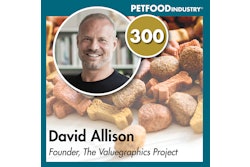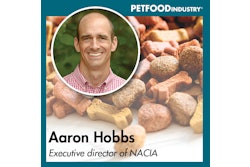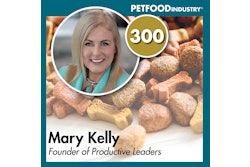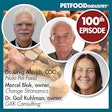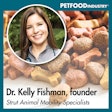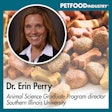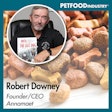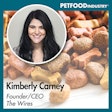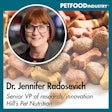
I spoke with Austin Therrell, executive director of the Association of American Feed Control Officials (AAFCO), about current regulatory hot topics in pet food ingredients, as well as what AAFCO does to help keep the pet food industry on top of things. Tune in if you want the latest!
The below transcript is from Episode 33 of the Trending: Pet Food podcast, where I spoke with Executive Director of the Association of American Feed Control Officials (AAFCO), Austin Therrell, about the latest in insect protein as a pet food ingredient in North America. You can find the episode at www.PetfoodIndustry.com/trending-pet-food-podcast, on SoundCloud or on your favorite podcast platform. This episode originally aired on April 26, 2023.
Lindsay Beaton – Editor, Petfood Industry magazine and Host, Trending: Pet Food podcast
Hello, and welcome to Trending: Pet Food, the industry podcast where we cover all the latest hot topics and trends in pet food. I’m your host and editor of Petfood Industry magazine Lindsay Beaton, and I’m here today with Austin Ferrell, executive director for the Association of American Feed Control Officials (AAFCO). Hi, Austin, and welcome!
Austin Therrell – Executive Director, AAFCO
Thanks! Thanks for having me on.
Beaton: If you’re involved with AAFCO at all you may be familiar with Austin, but in case you aren’t here’s what you need to know. Prior to his current role with AAFCO, he served on the Board of Directors and as the co-chair of the AAFCO Feed & Feed Ingredient Manufacturing Committee, as a member of the AAFCO Pet Food Committee, and as a member of the Current Issues and Outreach Committee. Austin previously served as the Animal Feed Program manager for the South Carolina Department of Agriculture where he oversaw animal food inspection priorities across the state, product registrations, labeling compliance, and a statewide sampling program. He graduated from Clemson University in 2013 with a Bachelor of Science degree in Animal and Veterinary Science and a minor in business administration.
AAFCO is an independent organization that has been guiding state, federal and international feed regulators with ingredient definitions, label standards and laboratory standards for more than 110 years, while supporting the health and safety of people and animals. Its members are charged by their local, state or federal laws to regulate the sale and distribution of animal feeds and animal drug remedies.
Austin Therrell is one of our Lunch n’ Learn speakers at Petfood Forum 2023, being held at the beginning of May, where he’ll be speaking on the “AAFCO ingredient perspective.” This, alongside his experience with all things pet food and feed ingredients, is why I’ve brought him on today to answer this question: What is the current state of regulation in pet food ingredients?
I know that's a pretty broad, sweeping question. And I don't always do this, but I want to start with a bit of a 101 question just so we can establish for anyone who might be newer to the industry and listening to this podcast, who AAFCO is and what AAFCO does. So my first question to you is, what are AAFCO’s main responsibilities when it comes to the pet food industry? And then I'd like to know a little bit more about you: What have you gotten involved in since you became executive director?
Therrell: Thanks again, Lindsay, for the opportunity to be on here. I think it might be easier to say maybe what I haven't gotten involved in! I started this role in September. There are a lot of things going on in AAFCO these days. In regards to the pet food industry, our responsibilities and our goals are really no different than they are with the feed industry. We're here, and our volunteer members are here, to create labels, standards, laboratory guidance, ingredient definitions, all that can be used to promote uniformity and consistency across the industry. We have a lot of different initiatives going on around those goals, but ultimately, since I came on board I've just been working to streamline a lot of our processes and make sure that the association is running smoothly to help accomplish those goals.
Beaton: How easy or challenging is it to streamline processes with something that covers so much ground? There's a lot going on in animal feed and pet food and everything that you guys have a hand in. So how much of it is streamlining and how much of it needs to branch out into the unique challenges of the various aspects of the industries you're involved in?
Therrell: That's a good question. Our association has been around since 1909, and really the focus of the association has never really changed much. We have a lot of processes in place as far as the ingredient definition process, some of the things to do within the model bill and regulations committee, and some of the other committees. But we do see a lot of changeover and personnel and people that are working in the regulatory side of this industry. Our state members have a lot of turnover, so we've got new volunteers coming in to participate within AAFCO all the time, which is a great thing. We have new perspectives that come in, bringing new people in and just kind of doing a refresh on processes that keep the association running smoothly is important. Then you did mention, you know, sometimes there's unique circumstances and there's topics and issues that come up across the country, and we handle all those on a case-by-case basis within the appropriate committees. But for the most part, streamlining what we do has been a big focus since I came on in September.
Beaton: I know education is a component of AAFCO when you're involved with the industries and helping out everybody involved in those industries follow regulations and do what needs to get done. With so much turnover within the areas that you're involved in, is there a lot of internal education that goes on, as well, as new people come into the fold, so to speak?
Therrell: Yeah, I think that'd be appropriate to say. In the same way that we try to put out educational resources and workshops and pet food labeling workshops for the industry, we do a lot of similar things internally with our members as well, where we do labeling workshops, we put on a basic inspector training and advanced inspector training, where we focus on inspection priorities, labeling, and a lot of those issues that are geared specifically towards new regulators or seasoned inspectors that just want to come in and have a refresher course. So we're putting a big focus on that and getting more training resources out there along with more online courses. Recently, our comprehensive ingredients submission course was altered. We're trying to work on different educational resources for industry, but also internally for our members as well.
Beaton: And speaking of education, that is what is going to be the rest of this conversation. We are going to educate people on what is going on right now in the regulatory landscape, particularly when it comes to pet food ingredients. So what are some of the hot-button topics that you guys are dealing with right now when it comes to pet food ingredients?
Therrell: There's always interesting things going on with ingredients and the AAFCO ingredient definition process itself. Before I move on just to ingredients, I mentioned we recently had a public hearing where we discussed the AAFCO FDA MOU (memorandum of understanding) that we have in place that kind of outlines the responsibilities of AAFCO and FDA within our ingredient definition request process. So we're excited to do that and to hear the feedback that's going to come out of that as we look to renew the MOU here in 2024.
And moving on into ingredients, we're, I know personally myself, just in the last few months I've seen a big interest in alternative protein sources like dried black soldier fly larva, cricket meal I think is in the pipeline, mealworms, a lot of insect-related ingredients that really are focused on sustainability. Besides those, I've also seen a lot of interest in human food byproducts that can have an impact potentially on the pet food industry.
Beaton: Let's talk about insect protein, because that's a real big topic right now in the pet food industry. Europe is a little bit further ahead of us when it comes to regulations and acceptance of insects in pet food, but we're chugging along here in the U.S. What has been your experience with the growth of insect protein as an interest as a pet food ingredient? And then what do you think 2023 is going to look like for insect ingredients?
Therrell: I certainly see things continuing to trend in that way. Like I said, I've already seen a lot of feedback and interest, at least on our side; it just seems like we're going to be looking at more of those kinds of ingredients coming through the approval process here in 2023 and 2024. That's partially one of the reasons that not only just for insect proteins, but for a lot of other ingredients that we offer, again that comprehensive ingredient definition module that's online training, we recently put on an ingredient submission workshop at our most recent meeting in San Antonio, Texas. And a lot of those are geared towards, with the increased interest in some of these new and novel protein sources and other ingredients, making sure that people understand what's needed to go through that approval process, what kind of data they need to substantiate and provide the CVM for those approvals, and those types of things. I think that we're going to continue to see more of it, especially as supply chains seem to still be a little bit tight from COVID, it seems like the industry may be looking elsewhere for alternative ingredients.
Beaton: And I think I already know the answer to this, but I'll ask it anyway: How much of a role does research in these novel, alternative, any ingredient that hasn't yet gone through the regulatory process and isn't yet established in the industry? How much influence does research and how important is research to getting that regulatory approval process moving and getting it integrated into all the ingredients that are already approved to use in pet food?
Therrell: That's honestly one of the biggest pieces of the puzzle when it comes to getting ingredient approval. I can't stress enough how important it is on the research side to have the data to substantiate any claim for a particular ingredient, the safety around it, how it can be safely used and the utility of it. There's a lot of different pieces to that puzzle, but certainly having a very concise and detailed data packet to go along with a new ingredient for CVM to review is really important. And the better the data, the better the packet is put together around that that could address any potential concerns, definitely helps to streamline and help that new ingredient move through the process as quickly as possible.
Beaton: How much does or can AAFCO assist with that sort of thing? If an entity comes to you and says we have this ingredient, we want to put it forward to try to figure out how to get it through the regulatory process, try to get it listed as an ingredient, really put the work in, how much do you help entities try to figure that out and help them help you in terms of what's needed to make things happen?
Therrell: That's certainly, I think, one of the biggest points to consider when looking at the AAFCO ingredient definition process versus food additive petitions or submitting a GRAS notice for something that is generally recognized as safe. AAFCO provides, and we have what we call AAFCO investigators for different types of ingredients, different categories for those ingredients: So whether that's amino acids, or vitamins, minerals, human foods, byproducts or miscellaneous products, we have individuals that serve in volunteer positions as AAFCO investigators. They are really the subject matter experts in that particular category of ingredients. So if someone's interested in submitting an ingredient through the AAFCO process, we put them in touch with the appropriate AAFCO investigator who can really be a guide for them in getting that submission through. They're going to help you go down the list of, like I said, all that data that needs to be included in a packet to go to CVM for review, let you know what you might be missing or what you might need. They're going to help you craft a definition and avoid any pitfalls you might have in trying to do this on your own.
We provide a tremendous resource in those investigators to help do that and to really kind of serve in the same way that, if a company was wanting to submit a new ingredient through a through a submission process, they can also go down that route and schedule a resubmission consultation, an AAFCO investigator kind of does a very similar job role, in that they help answer a lot of those questions to prep you for an official submission.
Beaton: I want to shift gears a little bit because there was something else that you mentioned a few minutes ago that I think is really worth expanding on and talking about a little more. You mentioned sustainability, and the use of byproducts from the human food space in animal feed and pet food. That's been a bit of a complicated topic for several years now because of the word “byproducts” and consumer perception and the language around it versus what the reality is. And there's a lot being said about consumer education for the potential of byproducts and kind of the cognitive dissonance between people saying that they want to be more involved in sustainability, and then overlooking something that could close a pretty big loop in the lifecycle of an ingredient and being able to use byproducts. Where are you guys at with that, or what are you hearing in the industry in terms of making use of byproducts working with the language that's been established, or maybe changing the perception for the furthering of sustainability? Where are you guys involved in all of that, and what are you hearing when it comes to that topic?
Therrell: You know, over the years I've always kind of heard the conversation piece around the term “byproducts,” whether that's human food byproducts or any other type of byproducts, that there's a negative connotation associated with it. And I think there probably is room for a decent outreach, along with industry to maybe do some outreach to change that. My biggest concern here, and I don’t mean to change the conversation, but going back to human food byproducts is we've seen a lot of the … byproducts that are approved substances for human food uses that are trickling their way down to maybe the pet food or feed industry. And it's important to note that just because a substance is generally recognized as safe or it's an approved food additive for humans, doesn't mean that it is approved for use in animals. There are ingredients on the market that are approved human food ingredients, or byproducts, that need to come through the approval process to make sure that they're safe to be used in animal food products. So that's one of the biggest concerns there.
Beaton: Is there a lot of nuance already involved in that, or is the process pretty sturdy? Or as sustainability becomes an even bigger conversation down the line, is there room for more nuance in trying to figure out exactly what byproducts are safe, what byproducts really just cannot go in pet food? Is there room for anything new to happen, or is everything pretty well established?
Therrell: Yeah, that comes back to talking about approval process, approval pathways. And I think those are all very well established. And honestly, from the human food side, if approved human food products or human food products have been on the market for a long time, there's likely a lot of that safety and efficacy data that can be extrapolated to animal food in some places. It's almost like they have a step ahead in creating that submission, putting that data together. But I certainly still need to go through that process to make sure that the CVM has a chance to review those ingredients to make sure that they're safe and appropriate for use with different animals.
Beaton: What would you say — and we've already talked about several of the top things going on in the industry right now — but in terms of challenges, what do you think is the top pet food ingredient challenge that you are seeing right now in the space?
Therrell: That's a tough one to boil down and just say there's one. I think that I would have to come back to the discussion with the human food byproducts. And just with discussions with different regulators and members across the country who are just seeing trends and more human food byproducts being used in the feed industry and pet food industry. A lot of times, I think that there may be an assumption that just because something's got a long history of use, humans have used it for a long time, that the assumption is made that it's safe for animals too, and that's just not always the case. I'd say it's more of an issue that we're looking into.
And then other than that, with COVID-19 and some of the supply chain challenges I think that came along with that, specifically with ingredients, just more opportunity for economic fraud, especially as we see high prices on commodities. Just ensuring that ingredients that are being received and used in the process are meeting spec sheets and those types of things. So that's another, I won’t say a challenge, but something I think we all, at least on the regulatory side, should be mindful of.
Beaton: Absolutely. How much of that on your side is preparation and being proactive so that you don't have to be reactive later, and how much of it is stuff that you're seeing actually coming to fruition after the last couple years? Is some of it just, we want to be able to prevent this if it comes up because the situation is ripe right now for that sort of thing to happen? Or are you actually seeing those problems and you're working behind the scenes to try to help everybody mitigate the damage?
Therrell: No, I'd say certainly the first one is something that I believe that some of our members are just, you know, proactively looking for, like you said, because of the supply chain issues that have come about and commodity prices, the opportunity is always there. It's not something that I think that we're seeing a huge issue with, but just something that we're trying to proactively take a look at to prevent.
Beaton: Let's move on from challenges. What is the most interesting thing that you're dealing with right now? When you get up in the morning and go to work, what's the most interesting topic that you're coming across or that AAFCO is dealing with right now?
Therrell: It would be a failure on my part to go on a podcast not bring up pet food label modernization. That's certainly probably one of the largest changes being discussed right now to the pet food industry and something we’ll be working on. Talking about pet food label modernization, this topic has been around AAFCO for least 10 or more years; there's been a significant amount of work done by AAFCO’s pet food committee, specifically the chairs of that committee, Stan Cook and Lizette Backman, to really bring that to fruition. It's really been exciting to work on, and it's interesting to see how that's coming through the AAFCO process and what those changes might look like for the industry here in the next five to 10 years.
Beaton: What are the expectations for 2023 as far as all of that stuff goes? In the next year or so what are you guys expecting to be able to come up with, or what steps are you going to be at by the end of the year, do you think?
Therrell: Certainly right now, this time as we're recording this podcast, the draft Model Pet Food Regulations is still within the workgroup, they're working on finalizing those and providing a recommendation and back to the AAFCO board of directors. So once that happens, AAFCO board of directors will likely review that this spring and make a recommendation to the membership. That means that if all that goes through, then the AAFCO membership will vote to accept those new Model Pet Food Regulation at our annual meeting in August (2023). So that will be when the membership has an opportunity to vote to pass or let that fail. And likely with the timing with that they're also working on implementation work, so, what kind of outreach is going to be done to state regulatory members, to industry, to consumers to let people know about the changes that may come about from pet food label modernization.
Beaton: Before we wrap things up I want to talk about the future a little bit more. You've been doing some streamlining, and it sounds like AAFCO has a pretty solid handle on everything that's going on. But the pet food industry is also continuing to diversify and get more complex. Pet owners are asking more than ever of their pets’ food, and that goes all the way back to the ingredients that go in that food. What do you see in general as the future of pet food ingredient regulations, and other than what we've already discussed, what is AAFCO expecting to be dealing with in the next couple of years? What are some of your other focuses?
Therrell: So, Lindsay, coming back to the ingredient regulations and the approval process, I think it's a big focus for us right now, especially considering, you know, some of the enhancements we make with FDA to the MOU to kind of streamline that process. And certainly we understand that these consumers want to have more knowledge about what products are going into the pet food products they’re buying for their animals. The AAFCO process is — I don't think I can stress enough how transparent it is, for those ingredients that come through that process to have the opportunity for state members to weigh in on those definitions and how they're crafted and worded, to have a say in whether or not membership accepts them or denies them, for industry to be a part of that process, to be able to work one-on-one with the regulators and on bringing those new ingredients to market, I think that that process and how we promote that process and really explain it to consumers is going to be a big deal, looking ahead to the future and not necessarily changing it but doing a better job of telling our story.
And the transparency and the collaboration that's involved within that process is something that we really want to highlight. There's not much else like it; it certainly doesn't happen on the human food side. And so it's encouraging that we have those processes, and that consumers can listen in to a meeting or even come to a meeting and participate, talk to their regulators and see what's going on for them.
So other than that, looking ahead into the future, back to discussing pet food label monetization and what that's going to look like, the changes that are going to come into effect potentially because of those new regulations. I think it's really exciting to see what the new labels are going to look like: How it's going to be more of a nutrition facts box-type label, some of the new guarantees that are going to be included on there and safe handling instructions and so on. I'm excited to continue to work with industry and work with regulators and see where that process leads and do the best job that we can to get the resources and the outreach out there over the next five to 10 years.
Beaton: Well, Austin, I really appreciate you taking the time to sit down with me today, because AAFCO is clearly such an integral part of the pet food industry. And there's always so much going on in terms of ingredients in animal feed and pet food that involves all of us that I think it's a good idea to sit down once in a while to see where we're at, where we're planning on going, and really kind of lay out the path on the regulatory side. Because it can be a mystery to some people if you don't know where to go, or if you're not able to keep up with things or if you're just in the day-to-day, but the regulatory process is really kind of an overarching, omnipresent thing when it comes to the success of the industry. So thank you very much for being on with me today.
Before we go, I want to do a little plug: Where can people find more information about you, and where can people get more information about AAFCO?
Therrell: Thanks, Lindsay. We just redid the AAFCO website. So there's some new resources and a new layout for everyone. So if you're interested in learning more about AAFCO, about our meetings, the different events that we do or any of the resources we have, including the official publication that we put out each year, you can find us at www.AAFCO.org and we have resources there for regulators, for industry and for consumers.
Beaton: Excellent. Once more, Austin Therrell will be speaking on behalf of AAFCO at our Wednesday Lunch n’ Learn session at Petfood Forum 2023 being held May 1 through 3 in Kansas City, Missouri. You can find more information about Petfood Forum at PetfoodForumEvents.com, and we hope to see you there!
That’s it for this episode of Trending: Pet Food. You can find us on www.PetfoodIndustry.com, SoundCloud or your favorite podcast platform. You can also follow us on Instagram at @trendingpetfoodpodcast. And, if you want to chat or have any feedback, I’d love to hear from you! Feel free to drop me an email: [email protected].
Once again, I’m Lindsay Beaton, your host and editor of Petfood Industry magazine, and we’ll talk to you next time. Thanks for tuning in!




